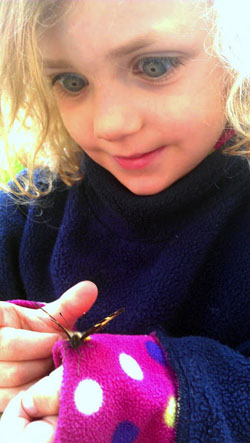by Rebecca Walker
As a family, we try to spend a lot of time outdoors. I’m always trying to encourage a love of nature in my children but I’m never sure how exactly to do that. Our days out mostly seem to be visiting places that like to involve children in nature. National Trust membership means we spend an awful lot of time visiting various of their properties. They’ve been making an enormous effort lately to be child-friendly and a big part of that is encouraging children to get outdoors and enjoy nature (see their ‘50 Things To Do Before You’re 11’ project https://www.50things.org.uk/). A recent favourite was the barefoot trail at Godolphin, ever since my daughter’s been insistent on going barefoot wherever possible. The Bat Cam at Arlington Court was a huge success. A very simple idea, but bats are now my four year old daughter’s favourite animal. We also visit the Eden Project and the RHS a lot. The RHS does some great seasonal trails for children and the Eden Project has many fantastic ideas. After one recent trip, the children enjoyed watching a tub of cress seeds growing and I was nearly able to persuade them to try eating it. All these places cost money though and not everyone is lucky enough to live near to places like that.
When I thought about it, I realised that our local woods are also pretty fun. I’m pretty sure they’re nothing special in terms of trees, but both my children love going there anyway. They hide behind trees, kick through leaves, look for insects (and the Gruffalo). It costs nothing and we all have a great time. We always come home with pocketfuls of leaves to be dried out so we can make collages with copious amounts of glue.
In fact, my children get most passionate about nature when they’re allowed to enjoy it by themselves. My toddler son will spend hours throwing stones into lochs, streams, puddles, anything he can find. Take him near water with a supply of stones and he’ll be happy for hours. Hegel said that children enjoy throwing stones as it’s their first impulse to influence the world around them and I’ve never met a child that doesn’t love throwing stones in the water. ”Even a child’s first impulse involves this practical alteration of external things ; a boy throws stones into the river and now marvels at the circles drawn in the water as an effect in which he gains an intuition of something that is his own doing” I’m always tempted to try and lure him away to another, more structured activity but then I wonder why I should stop him when he’s enjoying himself so much. As he gets older, I hope he’ll find other activities to enjoy around water like dam building, or pond dipping.
Over the summer my father-in-law found some small tortoiseshell caterpillars which he kindly collected and gave to us. We kept them in a bug habitat, feeding them with nettles. Over a few weeks, they pupated and eventually hatched into butterflies. When we released them into the garden, they were quite content to sit on our hands, before fluttering onwards and upwards. My daughter was rapt, as you can see from the photo. It was such a special experience for her that she was actually speechless. She now recognises small tortoiseshells on sight and has taken much more interest in all the butterflies that we see. As a result of that interest, she’s keen to attract more butterflies to our garden (and we’ve been looking at ways to do that) and has also been developing an interest in the local birdlife who are now fed very well indeed.
It’s so easy to think that teaching children a love of anything requires financial outlay,specialist equipment or structured activities. I’m sure all those things help, and I do applaud organisations that are trying to teach children about nature. Some of our experiences have been fantastic and I’m glad they’re on offer but there is such a wealth of opportunity in your back garden, or local woods, or the park. I believe that just letting children enjoy the landscape in their own way can be just as effective as any exciting day out. If we encourage them to love and value their landscape, then hopefully we can not only kindle a lifelong passion but help to shape how the next generation will treat these issues. Of course we all want to protect our most special spaces, but children can find magic anywhere and that is so very important.




























Very well articulated Rebecca. Your daughter looks absolutely entranced. That looks exactly like the kind of response that Richard Louv is seeking in the Children and Nature Network and here in the UK with the Save Childhood Movement and others in the Forest Schools Association; Learning through play. Brilliant. Thank you.